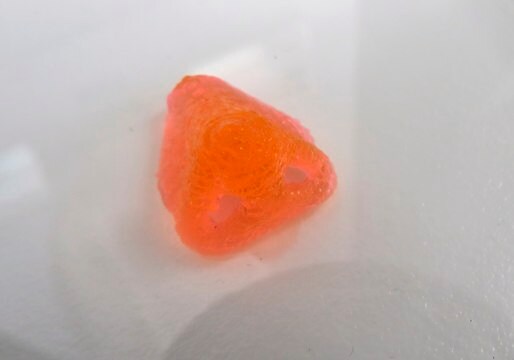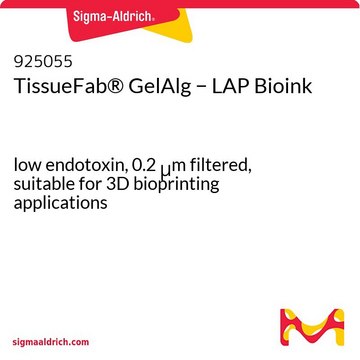推薦產品
描述
0.2 μm sterile filtered
suitable for 3D bioprinting applications
形狀
viscous liquid
雜質
≤5 CFU/g Bioburden (Fungal)
≤5 CFU/g Bioburden (Total Aerobic)
顏色
colorless to pale yellow
pH值
6.5-7.5
應用
3D bioprinting
儲存溫度
2-8°C
尋找類似的產品? 前往 產品比較指南
一般說明
應用
包裝
其他說明
- Optimize printing conditions (e.g., nozzle diameter, printing speed, printing pressure, temperature, cell density) for the features of your 3D printer and your application.
- Reduce bubble formation. Air bubbles in bioink may hamper bioprinting. Carefully handle the bioink when you mix and transfer it to avoid bubble formation. Do not vortex or shake vigorously.
Procedure
1. Prepare bioink: Keep TissueFab® - Sacrificial Bioink on ice to prevent gelation and gently invert the bioink to make a homogeneous solution. DO NOT vortex or shake vigorously. Transfer TissueFab® - Sacrificial Bioink into the desired printer cartridge.
2. Bioprint: Warm TissueFab® - Sacrificial Bioink in the printer cartridge to room temperature for 10–15 minutes to induce gelation. Follow the 3D printer manufacturer′s instructions. Load the print cartridge onto the 3D printer and print directly onto a Petri dish or into multi-well plates. Adjust the flow according to nozzle diameter, printing speed, printing pressure, and temperature. TissueFab® - Sacrificial Bioink can be printed in tandem with cell laden bioinks using additional printheads.
3. Optional Crosslink: If additional bioinks are used, crosslink the bioprinted structure before removing sacrificial scaffold following bioink instructions.
4. Remove sacrificial scaffold: Cool printed structure to 4 °C for at least 5 minutes. Rinse or perfuse with cold PBS.
5. Culture cells: Culture the bioprinted tissue with appropriate cell culture medium following standard tissue culture procedures.
法律資訊
儲存類別代碼
10 - Combustible liquids
水污染物質分類(WGK)
WGK 1
文章
Professor Shrike Zhang (Harvard Medical School, USA) discusses advances in 3D-bioprinted tissue models for in vitro drug testing, reviews bioink selections, and provides application examples of 3D bioprinting in tissue model biofabrication.
Professor Shrike Zhang (Harvard Medical School, USA) discusses advances in 3D-bioprinted tissue models for in vitro drug testing, reviews bioink selections, and provides application examples of 3D bioprinting in tissue model biofabrication.
我們的科學家團隊在所有研究領域都有豐富的經驗,包括生命科學、材料科學、化學合成、色譜、分析等.
聯絡技術服務








